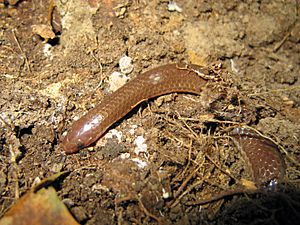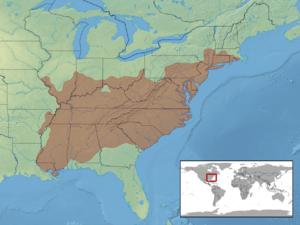Worm snake facts for kids
Quick facts for kids Carphophis amoenus |
|
|---|---|
 |
|
| Conservation status | |
| Scientific classification | |
| Genus: |
Carphophis
|
| Species: |
amoenus
|
 |
|
| Synonyms | |
|
|
The worm snake, also known as Carphophis amoenus, is a small, non-venomous snake. It lives only in the eastern United States. You can find it from Massachusetts down to Alabama and west to Louisiana and Illinois.
Worm snakes like moist places, especially rocky woodlands. They often hide under rotten logs, stumps, or rocks. Even though there are many of them, they are hard to spot. This is because they spend most of their time hidden underground. You might have the best chance to see one after a heavy rain. They prefer moist soil because their main food is earthworms.
Contents
What Does a Worm Snake Look Like?
The worm snake is a small snake. Adult worm snakes are usually about 7 to 11 inches (19–28 cm) long. The longest ever found was about 13 inches (34 cm).
These snakes are brown on their backs and bright pink on their bellies. The pink color often extends a little onto the sides of their bodies. Their skin is smooth, not bumpy. They have a pointed head and small, black eyes. Their tail is short and ends with a sharp, spine-like scale. Female worm snakes are usually longer than males, but males have longer tails.
Other small brown snakes might look similar, but the worm snake has a unique spine-tipped tail. Also, its body scales are smooth and usually in 13 rows.
Types of Worm Snakes
There are two main types of worm snakes:
- The eastern worm snake (Carphophis amoenus amoenus)
- The midwestern worm snake (Carphophis amoenus helenae)
The eastern worm snake lives from Rhode Island and Massachusetts down to South Carolina, Georgia, and Alabama. Young eastern worm snakes are much darker than their parents. They change from dark gray to brown as they get older. These snakes mostly eat earthworms, but they might also eat slugs or small salamanders. In some areas, like Massachusetts and Rhode Island, the eastern worm snake is protected because it is becoming rare.
Where Do Worm Snakes Live?
Worm snakes live in many states in the eastern United States. This includes southern Connecticut, Massachusetts, New York, New Jersey, Pennsylvania, Delaware, Maryland, Virginia, West Virginia, North Carolina, South Carolina, Georgia, and Alabama. They also live in the Appalachian Mountains in Kentucky and Tennessee.
How Worm Snakes Live
Worm snakes are great at burrowing, which means they dig and live underground. This is why you rarely see them. They are active at different times of the year depending on where they live. In warmer southern areas, they might be active almost all year. In colder northern areas, they are active from spring to fall.
During hot summer days, they stay underground or in rotting logs to avoid getting too hot or drying out. They use their small, pointed heads to push into cracks and holes in the ground. They usually become active in the late afternoon and early evening. Worm snakes don't move around much, but males tend to travel farther than females.
What Do Worm Snakes Eat?
Worm snakes mainly eat earthworms. They might also eat other soft-bodied bugs, like insect larvae.
Who Eats Worm Snakes?
Other animals that eat worm snakes include larger snakes, birds like thrushes and American robins, barn owls, and opossums.
Sometimes, worm snakes are killed by cars on roads. Flooding and other natural events can also affect their numbers. Sadly, human activities like destroying their habitat or using insecticides can also harm them.
When you handle a worm snake, it might release a smelly liquid from its tail. But don't worry, they are completely harmless to humans and almost never try to bite. They are very shy and gentle. If you pick one up, it will usually twist around, try to crawl between your fingers, and might poke you with its tail spine while releasing that strong-smelling liquid.
Reproduction and Life Cycle
Worm snakes usually mate in the spring, from late April to June. You can sometimes see the developing eggs through the female's skin in late May and June.
Females lay their eggs between early June and mid-July. A female will lay about two to eight eggs in a clutch (a group of eggs). The eggs are smooth and oval-shaped, about 0.6 to 1 inch (16–25 mm) long. They are often wider at one end.
The eggs hatch in August or early September. When they hatch, the baby snakes are about 4 inches (100 mm) long and are darker than the adult snakes. Worm snake eggs are often found hidden under rocks, inside rotting logs or stumps, in old sawdust piles, or even in old rodent burrows. Often, the mother snake stays near her eggs.
Worm Snake Populations
If the habitat is just right, you can find many worm snakes in one area. For example, in one hour, a group of researchers found over a hundred worm snakes under rocks in Kentucky! They are the most common snake in northern Virginia, with over 200 snakes per acre in some places.


